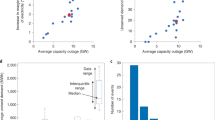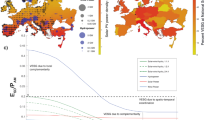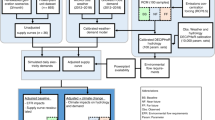Abstract
In the United States and Europe, at present 91% and 78% (ref. 1) of the total electricity is produced by thermoelectric (nuclear and fossil-fuelled) power plants, which directly depend on the availability and temperature of water resources for cooling. During recent warm, dry summers several thermoelectric power plants in Europe and the southeastern United States were forced to reduce production owing to cooling-water scarcity2,3,4. Here we show that thermoelectric power in Europe and the United States is vulnerable to climate change owing to the combined impacts of lower summer river flows and higher river water temperatures. Using a physically based hydrological and water temperature modelling framework in combination with an electricity production model, we show a summer average decrease in capacity of power plants of 6.3–19% in Europe and 4.4–16% in the United States depending on cooling system type and climate scenario for 2031–2060. In addition, probabilities of extreme (>90%) reductions in thermoelectric power production will on average increase by a factor of three. Considering the increase in future electricity demand, there is a strong need for improved climate adaptation strategies in the thermoelectric power sector to assure futureenergy security.
This is a preview of subscription content, access via your institution
Access options
Subscribe to this journal
Receive 12 print issues and online access
$209.00 per year
only $17.42 per issue
Buy this article
- Purchase on Springer Link
- Instant access to full article PDF
Prices may be subject to local taxes which are calculated during checkout



Similar content being viewed by others
References
US Energy Information Administration Independent Statistics and Analysis, International Energy Statistics http://www.eia.gov (2011).
Forster, H. & Lilliestam, J. Modeling thermoelectric power generation in view of climate change. Regional Environ. Change 4, 327–338 (2011).
Macknick, J., Newmark, R., Heath, G. & Hallett, K. C. A Review of Operational Water Consumption and Withdrawal Factors for Electricity Generating Technologies 29 (National Renewable Energy Laboratory, 2011).
NETL Impact of Drought on US Steam Electric Power Plant Cooling Water Intakes and Related Water Resource Management Issues (National Energy Technology Laboratory, 2009).
Vassolo, S. & Doll, P. Global-scale gridded estimates of thermoelectric power and manufacturing water use. Water Res. Res. 41, W04010 (2005).
King, C. W., Holman, A. S. & Webber, M. E. Thirst for energy. Nature Geosci. 1, 283–286 (2008).
Rubbelke, D. & Vogele, S. Impacts of climate change on European critical infrastructures: The case of the power sector. Environ. Sci. Policy 14, 53–63 (2011).
Boogert, A. & Dupont, D. The nature of supply side effects on electricity prices: The impact of water temperature. Econom. Lett. 88, 121–125 (2005).
McDermott, G. R. & Nilsen, Ø. A. Electricity Prices, River Temperatures and Cooling Water Scarcity (Discussion Paper Series in Economics 18/2011, Department of Economics, Norwegian School of Economics, 2011).
Arnell, N. W. Climate change and global water resources. Glob. Environ. Change 9, S31–S49 (1999).
Oki, T. & Kanae, S. Global hydrological cycles and world water resources. Science 313, 1068–1072 (2006).
Alcamo, J., Florke, M. & Marker, M. Future long-term changes in global water resources driven by socio-economic and climatic changes. Hydrological Sci. J.-J. Des Sci. Hydrologiques 52, 247–275 (2007).
Hagemann, S. et al. Impact of a statistical bias correction on the projected hydrological changes obtained from three GCMs and two hydrology models. J. Hydrometeor. 12, 556–578 (2011).
Nakicenovic, N. et al. Emissions Scenarios. A Special Report of Working Group III of the Intergovernmental Panel on Climate Change (Cambridge Univ. Press, 2000).
EEA Energy and Environment Report 2008 (Copenhagen, 2008).
IEA-NEA Projected Costs of Generating Electricity (International Energy Agency and Nuclear Energy Agency, 2010).
Koch, H., Vögele, S., Kaltofen, M. & Grünewald, U. Trends in water demand and water availability for power plants—scenario analyses for the German capital Berlin. Climatic Change 110, 879–899 (2012).
Liang, X., Lettenmaier, D. P., Wood, E. F. & Burges, S. J. A simple hydrologically based model of land-surface water and energy fluxes for general-circulation models. J. Geophys. Res. 99, 14415–14428 (1994).
Yearsley, J. R. A semi-Lagrangian water temperature model for advection-dominated river systems. Water Res. Res. 45, W12405 (2009).
NETL Coal Plant Database (US Department of National Energy Technology Laboratory; 2007).
VGE. Jahrbuch der europäischen Energie- und Rohstoffwirtschaft Vol. 118 (VGE Verlag GmbH, 2011).
Koch, H. & Vogele, S. Dynamic modelling of water demand, water availability and adaptation strategies for power plants to global change. Ecol. Econom. 68, 2031–2039 (2009).
Acknowledgements
This study was financially supported by the European Commission through the FP6 WATCH project and through the FP7 ECLISE project. We thank R. Leemans for helpful comments on a previous version of this manuscript. The Global Runoff Data Centre, 56068 Koblenz, Germany, and United Nations Global Environment Monitoring System are kindly acknowledged for supplying daily observed river flow and water temperature data for river stations in the US and Europe.
Author information
Authors and Affiliations
Contributions
M.T.H.v.V., P.K., D.P.L. and F.L. designed the study. M.T.H.v.V. performed all analyses and drafted the manuscript. J.R.Y. contributed to the model development. S.V. prepared and provided data sets of thermoelectric power plants. All authors discussed the results and contributed to the manuscript.
Corresponding author
Ethics declarations
Competing interests
The authors declare no competing financial interests.
Supplementary information
Rights and permissions
About this article
Cite this article
van Vliet, M., Yearsley, J., Ludwig, F. et al. Vulnerability of US and European electricity supply to climate change. Nature Clim Change 2, 676–681 (2012). https://doi.org/10.1038/nclimate1546
Received:
Accepted:
Published:
Issue Date:
DOI: https://doi.org/10.1038/nclimate1546
This article is cited by
-
Urban water and electricity demand data for understanding climate change impacts on the water-energy nexus
Scientific Data (2024)
-
Assessing compounding climate-related stresses and development pathways on the power sector in the central U.S.
Mitigation and Adaptation Strategies for Global Change (2024)
-
A framework to assess multi-hazard physical climate risk for power generation projects from publicly-accessible sources
Communications Earth & Environment (2023)
-
Global assessment of the carbon–water tradeoff of dry cooling for thermal power generation
Nature Water (2023)
-
Water consumption of electric power system in China: from electricity generation to consumption
Environmental Science and Pollution Research (2023)



